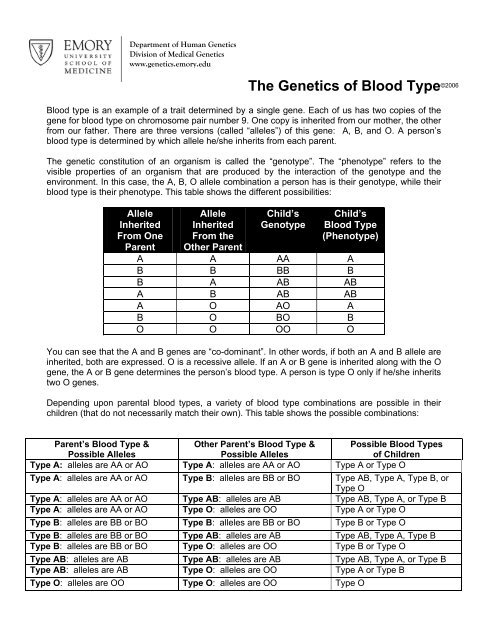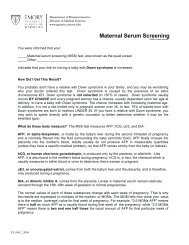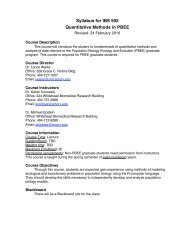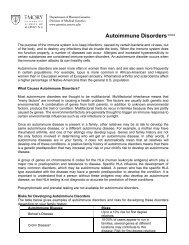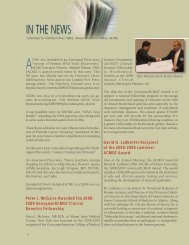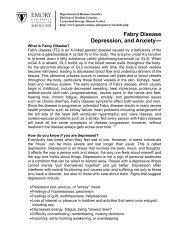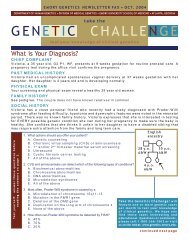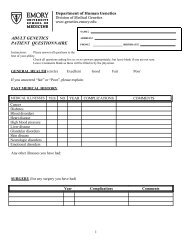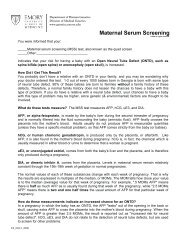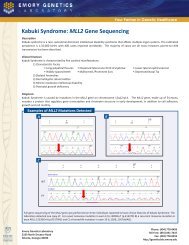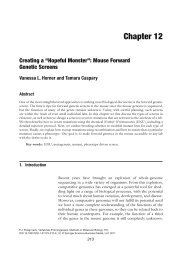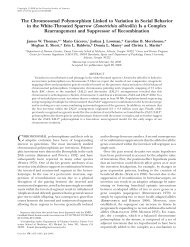The Genetics of Blood Type©2006 - Emory University Department of ...
The Genetics of Blood Type©2006 - Emory University Department of ...
The Genetics of Blood Type©2006 - Emory University Department of ...
You also want an ePaper? Increase the reach of your titles
YUMPU automatically turns print PDFs into web optimized ePapers that Google loves.
<strong>Department</strong> <strong>of</strong> Human <strong>Genetics</strong><br />
Division <strong>of</strong> Medical <strong>Genetics</strong><br />
www.genetics.emory.edu<br />
<strong>The</strong> <strong>Genetics</strong> <strong>of</strong> <strong>Blood</strong> Type ©2006<br />
<strong>Blood</strong> type is an example <strong>of</strong> a trait determined by a single gene. Each <strong>of</strong> us has two copies <strong>of</strong> the<br />
gene for blood type on chromosome pair number 9. One copy is inherited from our mother, the other<br />
from our father. <strong>The</strong>re are three versions (called “alleles”) <strong>of</strong> this gene: A, B, and O. A person’s<br />
blood type is determined by which allele he/she inherits from each parent.<br />
<strong>The</strong> genetic constitution <strong>of</strong> an organism is called the “genotype”. <strong>The</strong> “phenotype” refers to the<br />
visible properties <strong>of</strong> an organism that are produced by the interaction <strong>of</strong> the genotype and the<br />
environment. In this case, the A, B, O allele combination a person has is their genotype, while their<br />
blood type is their phenotype. This table shows the different possibilities:<br />
Allele<br />
Inherited<br />
From One<br />
Parent<br />
Allele<br />
Inherited<br />
From the<br />
Other Parent<br />
Child’s<br />
Genotype<br />
Child’s<br />
<strong>Blood</strong> Type<br />
(Phenotype)<br />
A A AA A<br />
B B BB B<br />
B A AB AB<br />
A B AB AB<br />
A O AO A<br />
B O BO B<br />
O O OO O<br />
You can see that the A and B genes are “co-dominant”. In other words, if both an A and B allele are<br />
inherited, both are expressed. O is a recessive allele. If an A or B gene is inherited along with the O<br />
gene, the A or B gene determines the person’s blood type. A person is type O only if he/she inherits<br />
two O genes.<br />
Depending upon parental blood types, a variety <strong>of</strong> blood type combinations are possible in their<br />
children (that do not necessarily match their own). This table shows the possible combinations:<br />
Parent’s <strong>Blood</strong> Type &<br />
Other Parent’s <strong>Blood</strong> Type & Possible <strong>Blood</strong> Types<br />
Possible Alleles<br />
Possible Alleles<br />
<strong>of</strong> Children<br />
Type A: alleles are AA or AO Type A: alleles are AA or AO Type A or Type O<br />
Type A: alleles are AA or AO Type B: alleles are BB or BO Type AB, Type A, Type B, or<br />
Type O<br />
Type A: alleles are AA or AO Type AB: alleles are AB Type AB, Type A, or Type B<br />
Type A: alleles are AA or AO Type O: alleles are OO Type A or Type O<br />
Type B: alleles are BB or BO Type B: alleles are BB or BO Type B or Type O<br />
Type B: alleles are BB or BO Type AB: alleles are AB Type AB, Type A, Type B<br />
Type B: alleles are BB or BO Type O: alleles are OO Type B or Type O<br />
Type AB: alleles are AB Type AB: alleles are AB Type AB, Type A, or Type B<br />
Type AB: alleles are AB Type O: alleles are OO Type A or Type B<br />
Type O: alleles are OO Type O: alleles are OO Type O
<strong>The</strong> “positive” or “negative” part <strong>of</strong> a person’s blood type is determined by a separate gene, called<br />
the Rh factor. Each <strong>of</strong> us has two copies <strong>of</strong> the gene for the Rh factor, on chromosome pair number<br />
1. <strong>The</strong>re are two versions (alleles) <strong>of</strong> the Rh factor gene: positive and negative. A person’s Rh<br />
status is determined by which allele he/she inherits from each parent. This table shows the different<br />
possibilities:<br />
Allele Inherited<br />
Allele Inherited From Child’s<br />
From One Parent the Other Parent<br />
Rh Type<br />
+ + +<br />
- - -<br />
+ - +<br />
You can see that the Rh-positive gene is dominant over the Rh-negative gene. A person’s Rh type<br />
is negative only if they inherit two Rh-negative genes.


